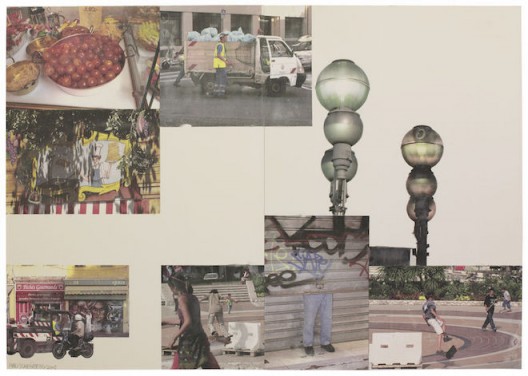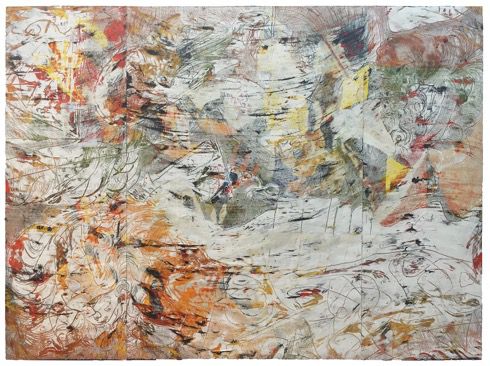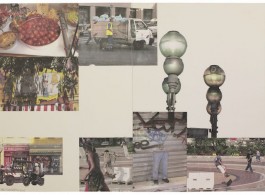de Sarthe Gallery
Hong Kong
26 May – 2 July 2016
de Sarthe Gallery, 8/F Club Lusitano, 16 Ice House Street, Central, Hong Kong

Robert Rauschenberg, Roundabout (Scenarios), 2005, pigment transfer on polylaminate, 217.2 x 306.1cm overall (two panels)
Art © Robert Rauschenberg Foundation/Licensed by VAGA, New York, NY
de Sarthe Gallery is pleased to announce a solo exhibition of Robert Rauschenberg in Hong Kong from May 26th to July 2nd 2016, featuring six significant works from different series created by the American artist, spanning from 1968 to 2005. Considered one of the most significant artists of postwar America, his works have been recognized as one of the major influences in the return to figurative art in the USA.
Rauschenberg is one of the three artists, alongside Jasper Johns and Allan Kaprow, who launched a radical shift, reacting against Abstract Expressionism and its emotional emphasis. Characteristic of the Neo-Dada movement, his works incorporate mass media and depict mundane subjects. This aesthetic research opened the door to Pop Art. The works in the exhibition illustrate Rauschenberg’s vision of the role of the artist, to him: “the artist’s job is to be a witness to his time in history”.

Wind Ballad, 2016, oil paint and fabric collaged on canvas, 72 x 96 x 2.5 in, 182.9 x 243.8 x 6.4 cm.
Courtesy the artist and Lehmann Maupin, New York and Hong Kong.
The earliest work by Robert Rauschenberg in this show, Bryce Baby, dated 1968, is a prime example of the artist’s experimentation with transfer drawings, a technique called solvent transfer. These transfer drawings render the collage elements onto a two-dimensional plane – using found photographs, comic strips and reproductions of artworks. Illeana Sonnabend, the artist’s primary dealer who greatly influenced the course of postwar art in the West, was a great advocate for Rauschenberg. The above work was exhibited at Robert Rauschenberg: Drawings, a show held at Ileana Sonnabend Gallery in Paris in 1968, and was sold later by her husband, the legendary art dealer Leo Castelli.
Stretch [Anagrams (A Pun)] (1998) is part of Rauschenberg’s Anagrams series created in the mid-1990s. The artist at that time developed a new technique, combining dye transfer with self-produced plaster sheets and polylaminate panels. This technique is another example of his subversion of traditional painting methods. The Anagrams series suggests that the juxtaposition of contents reinvents the way painting narrates through modern technology. In this particular work, the left side of a bedroom sketch contrasts with a telephone booth in the middle and rubber ball on the right side. These patterns recount the various stages of the artist’s youth. Rauschenberg’s use of vegetable dye transfer also highlights his environmental advocacy, in which the artist continued to raise awareness.
Also on show, Page 10 Paragraph 3 (2001) belongs to Rauschenberg’s Short Stories series, executed in the later stage of his career. This series consists of mixed-media works executed using pigment transfer or vegetable dye transfer onto a polylaminate material, a surface made of layers of laminated paper that are mounted on aluminum. This process developed by Rauschenberg’s Captiva studio illustrates the artist’s questioning of the distinction between art objects and mundane objects. The photograph-collage aesthetics of the artwork evinces the spirit and style of a narrative part of a story. With a lack of cohesive placement and order of the images, these open-interpretation works encourage the viewers to guide themselves into a journey heading towards a destination unbeknownst to them. Rauschenberg made the following statement about this series:
“Your story or dream… these are your personal treasures to share or keep secret… think of them as seeds…the stories can change as time does…move fearlessly with love” (Robert Rauschenberg: Recent works, Museum of Fine Arts, Boston, 2002).
Rauschenberg’s Roundabout (2005), Tenant (2005), and Rehab (2005), are also exhibited. These works are part of the artist’s large-scaled paintings series called Scenarios from 2002 to 2006. Each of the collage-like painting has a fairly literal depiction of the urban, suburban and rural American sites respectively. Continuing to adopt pigment transfer on polylaminate method, the artist preserved his legacy of merging technology with art. This series assembles various ordinary settings and objects of in various settings in America, serving as a colorful historical documentation of the multifaceted landscape defining his epoch for the future generations. The composition in Scenarios is a visual anagram that needs to be reassembled in our minds to form a commentary on the ever-growing globalization and modernization ofart.
The enduring legacy Rauschenberg continues, with new audiences experiencing his work across the globe. Following the comprehensive Guggenheim Museum (New York) survey of 1997, a major retrospective will be launched this year at the Tate Modern (London), whilst UCCA (Beijing) will present a monumental work by the artist, and trace his solo 1985 exhibition held at the National Art Museum of China. Delivering the works of this important 20th century American artist to Hong Kong, de Sarthe Gallery contributes to the rich international dialogue on Robert Rauschenberg.



